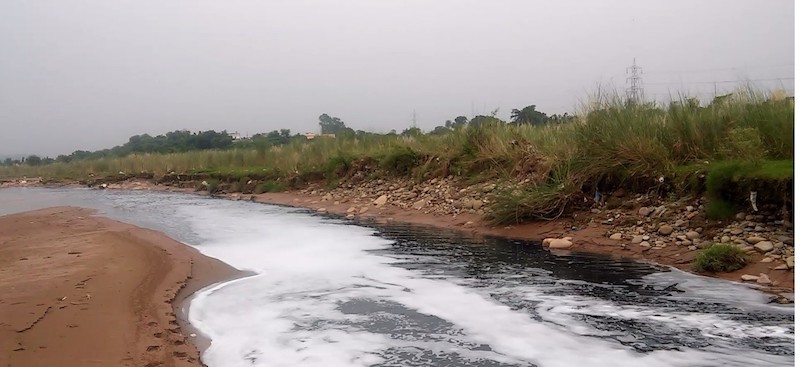Environment Group writes to NGT to appoint River Rejuvenation Committee
Demands Community Participation in making and implementation of action plans for restoration; Moratorium on industrial expansion in Baddi
The Himdhara Environment Research and Action Collective, a Himachal based watch dog group has appealed to the River Rejuvenation Committee and the Special Environment Surveillance Task Force to urgently look into the issues facing the Sirsa River in Solan which is amongst the most polluted rivers in Himachal. In a memorandum submitted to the state level bodies set up by the National Green Tribunal in view of the critically polluted river stretches in the country, Himdhara Collective has highlighted that industrial effluents from the Baddi Barotiwala Nalagarh (BBN) Industrial area, the discharge from a Common Effluent Treatment Plant (CETP), illegal open dumping of municipal garbage and unlawful sand mining are the chief sources of threat to the health of Sirsa River.
In September 2018 the Central Pollution Control Board released its report on “RIVER STRETCHES FOR RESTORATION OF WATER QUALITY identifying 351 polluted stretches on 323 rivers. In Himachal 7 river stretches have been identified as “critically polluted” by the report where the ‘Biological Oxygen Demand” levels of the rivers are above permissible limits. These rivers include Sukhana, Markanda, Sirsa, Ashwani, stretches of Beas, Giri and Pabbar. Sukhana, Markanda and Sirsa are in the worst condition within the 7.
Following the release of the CPCB report, the National Green Tribunal (NGT), on 20th September 2018 issued an order to States to form River Rejuvenation Committees for identifying the sources and nature of pollution of rivers and make time bound action plan for reviving the rivers. The River Rejuvenation Committee for Himachal comprises of Director of Urban Development Department, Himachal Pradesh, and team from IIT Kanpur and National Institute of Hydrology, Roorkee. The committee has to identify nature and sources of pollutants, device a time bound action plan to mitigate the pollution and revive the health of the river in collaboration with the State Pollution Control Board for implementation of the plan. In a follow up order dated 19th December 2018 the NGT has given all states 2 months time to complete their action plans. States which fail to comply will be fined 5, 10, 15 crores respectively for the different categories of priority.

The order of the NGT states, “Existence of polluted river stretches is evidence to show that the State Pollution Control Boards (SPCBs) have failed to perform their statutory obligation to take appropriate action to achieve the objects of the Water (Prevention and Control of Pollution) Act, 1974”. It has also been pointed out in the order that the action plans may be put up in the websites of respective SPCBs to keep the larger public informed about the same.
According to Himdhara member Sumit Mahar, “This is a very critical order of the NGT and perhaps goes to show that the crisis has assumed huge proportions because today almost 80 to 90% of our surface water sources are lost”. The submission made by the group has drawn attention to the fact that the impact of the pollution is most severe for the villages residing on both banks of the river, especially the Gujjar community whose cattle graze on the floodplains and drink and bathe in the rivers.
Adds Mahar,” The Common Effluent Treatment Plant made at Kenduwal has failed to address the problem of pollution. We have obtained data about water quality test from samples collected from discharge outlet of CETP done by the State PCB for past 3 years through RTI. From the data we can see that about half of the test results indicate that the values obtained are above the limits prescribed by the Central Pollution Control Board. The CETP has been served Show Cause Notices for the violation by the State PCB, however no further actions were taken.”
It is to be noted that the CPCB had issued an order to bring industrial units, sewage treatment plants and effluent treatment plants under the Zero Liquid Discharge (ZLD) Compliance in 2015, but it has not yet been implemented in the Baddi-Barotiwala-Nalagarh region. Several thousands of liters of effluents find their way to the Sirsa River every day, causing great damage to the aquatic life and leading to fish kills. The memorandum has also highlighted the issue of municipal garbage dumping on the floodplains of the Sirsa River in violation of the Solid Waste Management Rules 2016.
“Sand mining has been most detrimental to the health of the Sirsa, impacting the flow of the river and causing structural damage to the bridges across the river and buildings along the banks of the river. It is shocking that the NGT order dated 28 November 2013, which bans sand mining on river beds has been grossly violated” says Ramanathan S of the collective.
The memorandum has sought inclusion of testing for heavy metals like arsenic, mercury, hexavalent chromium in the samples for water quality and has emphasised on strict punitive actions by regulatory authorities on non complying units. “Unless communities residing in the area are involved in the making and implementation of the action plan, it is bound to be unsuccessful” adds Ramanathan. The submission also demands for a moratorium on further industrial expansion given that the Pollution Control Board is inadequately staffed to monitor and regulate the existing units and the carrying capacity of the area has been more than exhausted.



